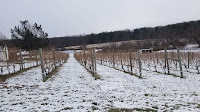One of the oldest on the line, Hamilton's train station dates from 1870. It was not in the original plan. When the Alexandria, Loudoun & Hampshire Railway (later the Washington & Old Dominion) was established in the 1840s, its owners intended to head the tracks westward along present Route 9 (Charles Town Pike), across the Blue Ridge at Keyes Gap, and on to the Ohio Valley coal country.The railroad reached Leesburg by 1860. Construction and operations ceased during the Civil War. By the time the railroad was up and running again, ownership had changed and so had the destination. The new route through western Loudoun County was slightly to the south of the original one, heading toward Snicker's Gap and sparking the growth of towns including Hamilton, Purcellville, Round Hill, and Bluemont. Unlike the other towns, however, Hamilton grew up along the automobile turnpike (Route 7) rather than along the railroad.
Historically, Loudoun County was part of the Fairfax Proprietary which King Charles II granted to seven noblemen in 1649. During the 1720s and 30s, Quakers settled in the area and formed the settlements which eventually became known as Waterford and Hamilton (Harmony). Soon thereafter this region was incorporated into a new designated Fairfax County and in 1757 the Virginia House of Burgesses divided Fairfax County with the western portion named Loudoun. This name was based on John Campbell, the fourth earl of Loudoun, a Scottish nobleman who served as commander-in-chief for all British armed forces in North America and governor of Virginia from 1756 to 1759.
The Hamilton Station depot served the town of Hamilton which was originally called Harmony in the late 1700s based on an estate built by Richard Tavenner his wife Ann Hatcher. At the turn of the century, the town became known as Hamilton Store because of a store opened by Charles Bennett Hamilton. The population increased due to the Leesburg and Snickers Gap Turnpike and in 1835, the town's name was shortened and codified when John Quincy Adams approved a post office located in Hamilton's store and the town's name was recorded as Hamilton.
After the Civil War, a steam railroad from Alexandria passed near Hamilton along the future route of the Washington and Old Dominion Railroad. Fleeing the summer humidity, tourists filtered into the town, and a 1+1⁄2-mile boardwalk was built to accommodate the new foot traffic. By 1900, the Town of Hamilton was Loudoun County's second-largest town. However, this growth was short-lived as the rise of the automobile slowed tourism traffic and a fire in 1926 consumed most of the town's central businesses. Today, Hamilton is known as a residential community.
I'm embarrassed to confess that yesterday was my first visit to The Barns at Hamilton Station Vineyards. The wines were what you would expect from Michael Shaps with the 2019 Cascina ($26) -- Seyval Blanc, Traminette, & Petit Manseng -- the table's favorite. I was also impressed with their 2018 Cabernet Franc ($24) and Petit Verdot ($28) for not only salvaging the rain-soaked grapes but producing very drinkable wines with them. The 1910 era barn is very cozy during the winter months and Ryan Jewel Music has a great country voice beyond his years. We look forward to returning in the spring to lounge on their patio and enjoy more wine and the surrounding views.


















































